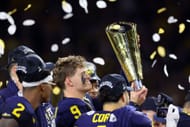It's not a stretch to say that following the House v. NCAA settlement, college football and college sports in general have changed forever. After more than a century of prohibition, schools will be able to directly pay student-athletes. It feels like the death knell for the amateurism of college athletics.
What is House v. NCAA? Why is it important?
House v. NCAA is a landmark class action lawsuit brought by former student-athletes against the NCAA and the Power Five conferences, alleging that the prohibition on schools paying student-athletes constitutes an antitrust violation. Former Arizona State swimmer Grant House and TCU basketball player Sedona Prince served as lead plaintiffs in the case.
Specifically, the plaintiffs argued that the NCAA rules constituted a violation of the Sherman Act. That setting the maximum compensation a student-athlete could get at a scholarship equaled price-fixing practices, and that schools had agreed not to freely compete for players. That, together with the fact that the NCAA controls the only viable path to professional sports, allows it to manipulate what would otherwise be a free market through practices that are tantamount to a monopoly.
The ruling body of college athletics decided to settle rather than face a lengthy and possibly fruitless court battle. The House v. NCAA lawsuit was initially filed in 2020, but in 2024, the NCAA filed settlement documents with the United States District Court for the Northern District of California.
Last week, Judge Claudia Wilken approved the settlement, which, according to the documents filed by the NCAA, will be "the largest payouts in an antitrust settlement in U.S. history."
What are the consequences of the House v. NCAA settlement?
The settlement will see the NCAA pay $2.78 billion over the next 10 years to former players who participated in college sports between 2016 and 2021. It also allows schools to set up to 22% of the yearly revenue by paying players through a revenue-sharing scheme for the use of their name, image and likeness (NIL). For year one, the hard cap is set at $20.5 million.
The House v. NCAA settlement also puts some restrictions on the way regular NIL deals are conducted. Deals worth $600,000 will have to be approved by an independent clearinghouse to ensure they fulfill what the NCAA is calling "fair market value" rules. According to estimates by Yahoo Finance, 70% of prior NIL deals don't fulfill this criterion. Consulting firm Deloitte has been named as the independent clearinghouse.
This could be problematic, as analysts estimate that $20.5 million per year wouldn't be enough to build a nationally competitive roster in today's college sports.
This is where traditional NIL deals would remain of key importance, as schools would move to get high-flying brands or booster collectives to sponsor their star players. Then they could focus their 22% cap on their less glamorous needs.
But will booster collectives, through which schools have funneled millions to star players, survive the new approval process or will the clearinghouse shut them down as nothing more than thinly veiled payments by schools?
Who are the winners and losers from House v. NCAA?
The biggest winners from the House v. NCAA settlement are, of course, student-athletes, who will finally get to share in the pie that is the business of college athletics. While some student-athletes have been making a buck from college sports since 2021, the reality is that it mainly benefited the stars who could get high-end NIL deals. Now, every player, at least in college football, stands to benefit.
That takes us to our biggest loser: Every other sport. With the possible exception of basketball, all other sports are set to be sacrificed in the name of football.

College football is by far the most profitable of all collegiate sports, and it's expected to see schools devote the majority, if not all, of their $20.5 million budget to this sport. Don't expect to see baseball players or Olympic athletes making a living out of revenue-sharing payments from their schools. The economics just aren't there.
There's the exception of college basketball, which has a strong fandom of its own. Women's college basketball, especially, has been growing in popularity over the last few years, and this is a place in which schools could invest to avoid Title IX violations.
Finally, schools themselves could be divided between winners and losers. Big schools, or at least schools with their finances in order, stand to profit the most. Athletic directors at powerhouses, like Ohio State's Ross Bjork, have already declared their enthusiasm for the new system.
Nonetheless, athletic departments unable to spend 22% of their revenue could suddenly find themselves lagging in a new arms race. Recent statements by Michigan's athletic director, Warde Manuel, concerning the impact this new scheme could have on his department's debt show that not even big schools are immune to being adversely affected.
Only time will tell who will win this new arms race.
